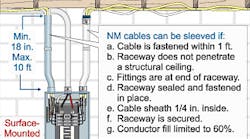All questions and answers are based on the 2008 NEC.
Q. What are the termination requirements where NM cables enter a panel?
A. All cables must be secured to the enclosure with fittings designed and listed for the cable [312.5(C)]. See 300.12 and 300.15.
Cable clamps or cable connectors must be used with only one cable, unless that clamp or fitting is identified for more than one cable. Some Type NM cable clamps are listed for two Type NM cables within a single fitting (UL White Book, product category PXJV).
Exception: Cables with nonmetallic sheaths aren't required to be secured to the enclosure if the cables enter the top of a surface-mounted enclosure through a nonflexible raceway not less than 18 in. or more than 10 ft long, if all of the following conditions are met:
(a) Each cable is fastened within 1 ft from the raceway.
(b) The raceway doesn't penetrate a structural ceiling.
(c) Fittings are provided on the raceway to protect the cables from abrasion.
(d) The raceway is sealed.
(e) Each cable sheath extends not less than ¼ in. into the panelboard.
(f) The raceway is properly secured.
(g) Conductor fill is limited to Chapter 9, Table 1 percentages (Figure).
Q. The Code uses the term “readily accessible” in a few areas, but I don't know what that means. Please help.
A. Article 100 defines readily accessible (accessible, readily) as capable of being reached quickly without having to climb over or remove obstacles or resort to portable ladders.
Q. For a townhouse situation, can we run the feeder circuits for one unit through the attic of the neighboring units?
A. The NEC doesn't prohibit this, but there may be local rules (such as real estate law) that prohibit the practice.
Q. Would a 15A or 20A receptacle installed in a boathouse require in-use covers?
A. It depends. Receptacles installed in a damp location must be installed in an enclosure that is weatherproof when an attachment plug cap is not inserted and the receptacle cover is closed, or an enclosure that is weatherproof when an attachment plug is inserted.
Damp locations include those protected from weather and not subject to saturation with water or other liquids, as well as locations partially protected under canopies, marquees, roofed open porches, and interior locations that are subject to moderate degrees of moisture, such as some basements, barns, and cold-storage warehouses [Art. 100].
Receptacles installed in a wet location must be within an enclosure that is weatherproof when an attachment plug is inserted [406.8(B)(1)]. According to Art. 100, a wet location is defined as an installation subject to saturation with water and unprotected locations exposed to weather.
Q. Does the NEC require a specific “color code” for switch legs and travelers?
A. No, but a white conductor within a cable can only be used to supply power to single-pole and for 3-way or 4-way switch loops if permanently reidentified at each location where the conductor is visible to indicate its use as an ungrounded conductor [200.7(C)(2)]. In addition, a green colored conductor is never permitted to be used for anything other than an equipment grounding conductor [250.119].
Q. For a 400A service, what size wire do I need to run for my ground rod?
A. Where the grounding electrode conductor is connected to a ground rod, that portion of the grounding electrode conductor that is the sole connection to the ground rod isn't required to be larger than 6 AWG copper [250.66(A)].
Q. Can we install a panel in the same room as an air handler and a water heater?
A. Sure, assuming that all clearances required by 110.26 are complied with.
Q. When does the Code require plastic bushings over raceway fittings?
A. Where raceways contain insulated conductors 4 AWG and larger that enter an enclosure, the conductors must be protected from abrasion during and after installation by a fitting that provides a smooth, rounded insulating surface, such as an insulating bushing [300.4(G)]. Where IMC or RMC conduit enters an enclosure without a connector, a bushing must be provided, regardless of the conductor size [342.46 and 344.46].
Q. Can I have low-voltage lighting for the stairs next to my hot tub? The lights would be about 3 ft from the water's edge.
A. No, low-voltage lighting systems must not be installed less than 10 ft from the edge of the water [411.4(B)].
Q. Does hard-wired equipment in a commercial kitchen require GFCI protection?
A. No, only 15A and 20A, 125V receptacles in the kitchen must be GFCI protected [210.8(B)(2)].




